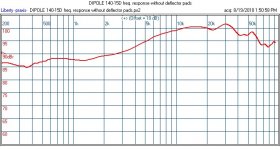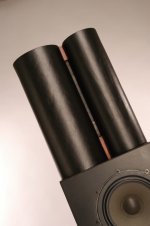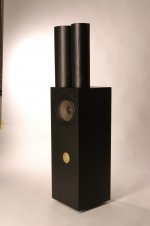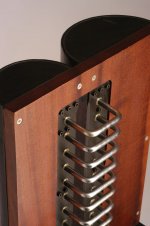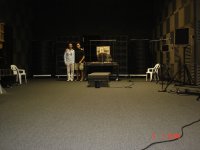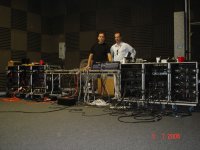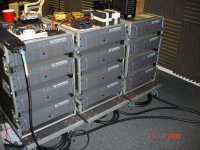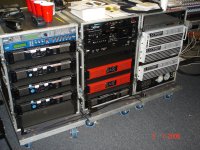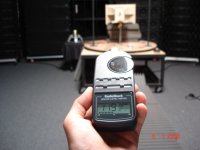for sure
Those amps are not really suitable for OB to say it loud and clear - at least not if you are seeking SPL plus some headroom - and on top of that passive XO possibly.
OB / nude is sheer waste of power to a considerable degree - a luxurious design attempt in any way ...
Use two of these (Scan-Speak 15M/4624G Discovery) - one above the other - and you are almost there..
https://www.madisound.com/store/product_info.php?products_id=8926
IMO pretty sonics for that bargain price too.
Michael
Oh, yes, they certainly are in driving mids and highs! Passive XO between mid and high doesn't hurt it, if designed nicely. It goes without saying that EQ headroom for the low 15" or two, will a big solid state or a D-class.
I assume OB should use EQ, and I assume you need a separate amp for the job that wouldn't be 25 Watts.
As for the number and kind of mids I like to use, please read my previous post.
Nothing like it, if you want to hear the actual size and feel of the instruments, and horns can't touch it, with their "in your face" presentation. The way I like to put it, they have a big sound, but not big instruments.
.
This your believe will change dramatically - once you did a optimized dipole horn for your speaker and drive it properly - believe me...
Michael
I've built and listened to a handful of dipole tweeters, and they've all had errors - but personally, I don't hear the 8kHz deviation.
It's not the 8k dip but the 15k peak that worries me. Our ears are not very sensitive to dips as much they are to peaks.
I have listened to the neo3 and didnt like it. I generally find very unpleasant (and discard) speakers which have a raising HF response or even peaks.
Most other dipolar tweeters have errors in the 1kHz-5kHz range, where our ears are most sensitive, and the error is very obvious.
This is correct.
so far my refenence is the Precide heil - it's clean and flat, but not much efficient unfortunately.
........
If you want to get truly remarkable results in midrange, use 3" FR driver in clusters of 2x4, 3x3 or 6 pieces in hexa and one in the middle for total of 7. ......
funny ;
I have one friend who's having something similar in his basement ........

To the difficulties you noted, I would also add the sensitivity issue, which is disregarded here.
Let's not mix apples and oranges, as 90dB/Watt allows a speaker designer a completely different vantage point than 95dB/Watt.
Hi Aleksander.
No, it's not disgarded at all, for me at least. 95dB is the very minimum i would shop for. And i've got the beyma tpl-150 mostly because of its higher efficiency. I would need to more than double the power of my tweeter amp to settle for a 95db tweeter. It must be well worth the effort.
Unfortunately, efficiency goes up with size... I still have to see big enough neo magnets to do 100db (from 5k-6khz up) with a 5x5cm max surface.
Most people here are satisfied with 90dB, though.
The problem is that there aren't much mids out there that are churning out 96.5 or 95 dB/Watt flat responses and the ones that do that, are not small filler drivers, but 8" exotics, like Supravox 215 variety, Seas exotic 8, and such. No planars in the game, either.
No, but mids can be used in a d'appolito setup adding 3db efficiency and can use a more traditional amplifier, even a class AB one (at least in my case, with more attention to THD rather than perfect HF response to at least 100khz).
So, my question is, if you were to design a dipole 95-96 dB/Watt speaker, having in mind that you'll have to use an 8" midrange, crossing is as low as possible, what would be the tweeter format that you'd like to use?
I'm not John (although i mostly agree with what he says)
I do 4 way -anything less IS a too big compromise, with an extended midrange which is not isodinamic.
Something like the MAD-1 fill the bill, or the neo10, or even better the FAL.
Those amps are not really suitable for OB to say it loud and clear - at least not if you are seeking SPL plus some headroom - and on top of that passive XO possibly.
OB / nude is sheer waste of power to a considerable degree - a luxurious design attempt in any way ...
I dont know how much you loose with a naked tweeter (vs tiny baffle from 5k up), but in my calculations 25W are sufficient for a 95db tweeter like the new Raal and that 10-15W are for one such as the tpl-150 or the ESS great heil, all highpassed HIGH, way higher that seems the trend in this thread.
Of course i'm talking active multiamping.
And yes it's obviously a "luxiorous design attempt" but I have NEVER listened to a non class A amp that sounded good in the HF.
Never.
you should know that a good cone driver does things better up to 1k5-2k than a ribbon ever could dream of. That is why electrostats and big planars sound wimpy with drums, percussion and piano.
Funny, I always loved the ribbons in the midrange for the amazing violins they offer. Looks like we cannot have the cake and eat it too eh?
In midrange, parachute effect, or large air loading, needs to be controlled with greater force per surface area than any ribbon, stat or planar can give.
Trust me, you're much better off with cones in midrange.
If you want to get truly remarkable results in midrange, use 3" FR driver in clusters of 2x4, 3x3 or 6 pieces in hexa and one in the middle for total of 7. Do not use line sources, they don't add together well, as top driver doesn't know what bottom driver does and vice versa, meaning that they don't share the load and sound equally wimpy just like one feeble 3" driver, only you can cross it a bit lower. Sharing the air loading is the key, a such 3" FR drivers clusters are the way to go. They get so much authority and slam that it;s not even funny. The main advantage to a comparable surface area of just one cone driver, is that 3" FR will have first cone breakup problems even as high as 11k, so you'll end up having a piston of a large area all the way up.
This is a very nice idea! Even if i have found drivers without cone breakup
Only a few bright examples exist, made by people that understand the drawback of it.
Please feel free to share them.
So far I have only liked a couple of 12" widerange cones (yes 12" OB in untreated rooms are THE best midrange so far, but baffles do not need to be huge).
funny ;
I have one friend who's having something similar in his basement ........

Thanks for the link to the burning amp gallery :
http://www.burningamp.net/gallery/i...urningamp.net/gallery/image/342-raaldipoljpg/
An externally hosted image should be here but it was not working when we last tested it.
Puts size into perspective
Michael
Last edited:
As for the number and kind of mids I like to use, please read my previous post.
Depends -
*If* clustering 3 x 3" in the horizontal line (hex arrangement) you may end up with a highish break up frequency but beaming comes in low.
*If* you choose to "power split" in concentric radii (ESL-63 style) the advantage of SPL addition / headroom is lost at top end.
No free lunch IMO, also regarding excursion at low THD...
Michael
Fountek
These wave guide Fountek ribbons are really cheap.
.
https://www.madisound.com/store/product_info.php?manufacturers_id=132&products_id=8818
These wave guide Fountek ribbons are really cheap.
.
https://www.madisound.com/store/product_info.php?manufacturers_id=132&products_id=8818
Hola muchachos!
mige0,
I was talking about compression drivers and horns. Having back radiation changes situation dramatically, I believe you. I've been around the block a few times, you know. See what I was playing with back in '95. It was during the war, so there was nothing better to do as economy was ruined. Nothing better than playing with Pass' Zen, SE tube amps, Moscodes, etc. and building speakers, he, he! Not so bad, hey! I did try the front back horn, too. When I mentioned the instrument size, I wasn't referring to HF, as I don't think the instrument size lays in that bush. More of a something below 1k5, but mostly between 200 and 1k. If you dry the room out of that with a dipole or a horn, you may, just may, get cleaner sound in general, but it still doesn't compare to a treated room with omni. Probably because it's not natural.
when i said 3x3, i meant 9, with 2x4 or 2x3, i mean 8 and 6 and with hex+1 in the middle i meant 7, used for midrange above 200Hz.
Of course, beaming gets very tight up there, but as you've said, no free lunch.
Hi Telstar,
Beyma 150 is an interesting beast! here's a plot of dipole 140-15D without acoustic lens. this will make a better comparison to the Beyma tpl150, as they're about the same vertical size. If you're not crossing low, and maybe you don't as you use 4-way, I don't think you'll loose much of the efficiency, if you don't mind the same beaming.
Aaaah, MAD planar. Designed by my first mentor, Dragoslav Colich for HPV. What a jewel that is! It plays so effortlessly relaxed, smooth and soft but with a slam and kick I've never heard out of a planar! Had a pair for a couple of months and living with those was sweet. Are they available now? They used to be $1k a pop...
I've been told great things about BG neo10. I think I'll get a pair.
I need to listen FAL somewhere. I'm very curious.
Well, for one Per Skaaning is the one that knows how not to overdo the ring thing.
Yup, multiplying them little critters will be the center of the new OB speaker I'll do, following that narrow midrange - wide flush HF approach. Not because it's easier done that pushing dipole high up, but because it still makes more sense to me. I know what I've heard and the "big midrange" does the trick for me when OB is in question. Well, if anything is in question, big mids are the ticket. By big midrange driver, I also think cluster of 3"-ers, just to be clear.
Fountek is a phenomenal value for money! I'll shake hands and take a picture with Fountek guys if I ever meet them.
mige0,
I was talking about compression drivers and horns. Having back radiation changes situation dramatically, I believe you. I've been around the block a few times, you know. See what I was playing with back in '95. It was during the war, so there was nothing better to do as economy was ruined. Nothing better than playing with Pass' Zen, SE tube amps, Moscodes, etc. and building speakers, he, he! Not so bad, hey! I did try the front back horn, too. When I mentioned the instrument size, I wasn't referring to HF, as I don't think the instrument size lays in that bush. More of a something below 1k5, but mostly between 200 and 1k. If you dry the room out of that with a dipole or a horn, you may, just may, get cleaner sound in general, but it still doesn't compare to a treated room with omni. Probably because it's not natural.
when i said 3x3, i meant 9, with 2x4 or 2x3, i mean 8 and 6 and with hex+1 in the middle i meant 7, used for midrange above 200Hz.
Of course, beaming gets very tight up there, but as you've said, no free lunch.
Hi Telstar,
Beyma 150 is an interesting beast! here's a plot of dipole 140-15D without acoustic lens. this will make a better comparison to the Beyma tpl150, as they're about the same vertical size. If you're not crossing low, and maybe you don't as you use 4-way, I don't think you'll loose much of the efficiency, if you don't mind the same beaming.
Aaaah, MAD planar. Designed by my first mentor, Dragoslav Colich for HPV. What a jewel that is! It plays so effortlessly relaxed, smooth and soft but with a slam and kick I've never heard out of a planar! Had a pair for a couple of months and living with those was sweet. Are they available now? They used to be $1k a pop...
I've been told great things about BG neo10. I think I'll get a pair.
I need to listen FAL somewhere. I'm very curious.
Well, for one Per Skaaning is the one that knows how not to overdo the ring thing.
Yup, multiplying them little critters will be the center of the new OB speaker I'll do, following that narrow midrange - wide flush HF approach. Not because it's easier done that pushing dipole high up, but because it still makes more sense to me. I know what I've heard and the "big midrange" does the trick for me when OB is in question. Well, if anything is in question, big mids are the ticket. By big midrange driver, I also think cluster of 3"-ers, just to be clear.
Fountek is a phenomenal value for money! I'll shake hands and take a picture with Fountek guys if I ever meet them.
Attachments
I just have to post this!
My first mentor, Dragoslav Colich, co-creator of Monsoon and creator of MAD planars. He's in shorts. We are listening to two panels consisting of 64 MAD drivers on a side, with 24 OB peerless XXLS 12" on a side, with a silly number of amps and power involved.
Now, that was something to remember! That 119dB was the average SPL, slow setting, C weighting. And there was no pain or anything that will make you turn it down.
My first mentor, Dragoslav Colich, co-creator of Monsoon and creator of MAD planars. He's in shorts. We are listening to two panels consisting of 64 MAD drivers on a side, with 24 OB peerless XXLS 12" on a side, with a silly number of amps and power involved.
Now, that was something to remember! That 119dB was the average SPL, slow setting, C weighting. And there was no pain or anything that will make you turn it down.
Attachments
Hi,
Thanks a lot for sharing. Very interesting dirver. Is that 'ladder' at the rear the magnetic circuit?
No, the ferrite magnets are below the plates, those are iron bridges to close the flux. The XO is at 1k8 and it has 90 dB at the front with that assymetrical horn that allowed for very little towing in. It sounds silly today, but I didn't know better back then. Still, the nature of the beast was obvious.
I've been around the block a few times, you know.
certainly
It sounds silly today, but I didn't know better back then. Still, the nature of the beast was obvious.
Regarding round over's, horn's etc. things have slightly moved since then and perspective got shifted...
This is 1" driver at 2" round over :


Not that bad - but there is room for improvement...
Michael
Last edited:
Well the Neo3 eq'ed flat on axis certainly didn't retain that response off axis for me. I don't see how that could happen as the dipole peal and first null mover higher in frequency as the off axis angle increases.
A lot of the theory on your website is based on the premise that the dipole peak shifts to a higher frequency when you go off-axis, but I don't think this is correct. It is true if you consider two physically separated point sources, but it is not for a back and forth moving plane. Then the dipole peak actually shifts to a lower frequency when you go off-axis. This has to do with the bulk of the sound having to move around the driver/baffle and thus having to travel a larger distance. The shift to a lower frequency can easily be measured, so I'm a bit surprised that you claim differently.
A lot of the theory on your website is based on the premise that the dipole peak shifts to a higher frequency when you go off-axis, but I don't think this is correct. It is true if you consider two physically separated point sources, but it is not for a back and forth moving plane. Then the dipole peak actually shifts to a lower frequency when you go off-axis. This has to do with the bulk of the sound having to move around the driver/baffle and thus having to travel a larger distance. The shift to a lower frequency can easily be measured, so I'm a bit surprised that you claim differently.
That is not correct. To restate things a little differently, at low frequency where the response rolls off a 6dB/octave, that roll off is basically the same as a 1st order high pass filter with pole at the (theoretical) dipole peak. If the peak moved lower in frequency, the response off axis would be at a higher level that the on axis. It should be obvious that the effective separation between the front and rear sources must decrease because, obviously at 90 degrees the separation goes to zero or you would not have a 90 degree null. When we have a driver on a baffle the separation doesn't exactly follow the cos(theoretical) relationship, but the separation is a maximum on axis and becomes smaller as we move off axis.
You may or may not observe the movement of the peak higher in measurements because of other factors such as baffle size/shape, driver directionality, asymmetry between front and rear response, and the fact that the rear radiation that sums to the front acts as a distributed source around the baffle edge, but it is not uncommon to measure this effect.
Here is a simulation of a 20 cm driver centered on a 40 cm square baffle for the on axis and 60 degree off axis response. Yes, it is only a simulation but it is reasonable representative of measured data.
An externally hosted image should be here but it was not working when we last tested it.
Hi John,
You're a highly regarded loudspeaker designer and your work is always thorough, it brought so much useful data to wide audience and it was always discovering the good features of affordable components, giving valuable advice to DIY community.
Surely, you must know what would you like to have, regarding dipole tweeters format. You can't just sit back and let me guess what it is. If you're not happy with current offerings, then please define what optimal is. You may be used to manufacturers that don't listen, but I do listen and try to do my best to serve the needs.
Because of that, I have question to ask you, after I point out one thing.
To the difficulties you noted, I would also add the sensitivity issue, which is disregarded here.
Let's not mix apples and oranges, as 90dB/Watt allows a speaker designer a completely different vantage point than 95dB/Watt.
If your choice of amplifier is, say, 25 Watt Firstwatt J2 or any other 15-25 Watt beauty out there, problems start to jump out of the closet. You'd be aware of the potential, but you wouldn't be able to use it with 90 dB/Watt speaker, and that is very frustrating. You'd want at least 95 dB/Watt speaker to match.
For example, closed 140-15 has 95 dB/Watt (not 2.83V), or more, depending on the foam pads positioning. The dipole version, due to increased air loading mass, has about 1.3 dB less with same response curve.
Experience shows that for a good tone balance of the loudspeaker, they both require about 1.5dB more efficient midrange due to dynamic compression issues on the midrange side and due to wider dispersion on the ribbon side.
The problem is that there aren't much mids out there that are churning out 96.5 or 95 dB/Watt flat responses and the ones that do that, are not small filler drivers, but 8" exotics, like Supravox 215 variety, Seas exotic 8, and such. No planars in the game, either.
The mid will start beaming fairly soon and you can't use a filler driver, because there isn't any variety of 4-5" 95 dB's to choose from.
Just 3dB, let alone 5dB in increased sensitivity demand by the customer, changes the game completely and 50 bucks is not considered a chip any more, due to exponential increase in difficulty of designing and building such a thing. 90 dB/ Watt allows much more liberty and it's easy compared to 95dB/Watt.
So, my question is, if you were to design a dipole 95-96 dB/Watt speaker, having in mind that you'll have to use an 8" midrange, crossing is as low as possible, what would be the tweeter format that you'd like to use?
I think I nailed it pretty close, for what it s intended for, but I'd like to know what would you do, if it ain't a secret.
I'm asking because I may want to provide certain features to the baffle so everybody would be happy.
One possible way to do this is to increase the iron yoke size, but drill a large number of 1/2" to 3/4" holes through it. That way, you can choose which holes to plug and which to leave open, creating different patterns that just might fit any dipole taste, without increasing efficiency.
Thanks for the compliment, and you should know that I respect RAAL products. But they just aren't my cup of tea. I'm not particularly interested in high aspect ratio radiators, be they tweeters or otherwise. I'm actually toying with the idea of placing a circular wave guide on the Neo3 for the next generation Note. We'll see. I'm not ducking your questions but I really don't know what optimum configuration would be. I know what I would like for the response. I guess if I were to try to design a true dipole tweeter is would be very similar to what Rudolf was proposing many posts ago, back to back domes which radiated as a true dipole but for which directionality took over before the on axis nulls appeared.
I also can not tell you how I would design a higher efficiency speaker. It is not something I would comment on off the cuff. But I can tell you I would not be using any type of gradient woofer system. If I wanted high efficiency across the spectrum I think I would pretty choose to suffer loss of accuracy the much go with a ported woofer. After that I just don't know.
Hello all,
That is the old fashioned engineering point of view but unfortunately it does not make any psychoacoustical sense. What we really need is monotonically widening dispersion somewhere above 3kHz. To minimise the cross talk artefacts of stereo one needs to spatially homogenise the pinna cues and that is most easiest done by providing very wide dispersion at treble, almost omnidirectional above 3kHz.
Also in the midrange below 1kHz one needs to minimise room reflections to be able to provide stereo ITD cues and that is best done with very narrow dispersion.
Clearly it turns out the ideal loudspeaker directivity is not constant, not narrowing but widening!
This radical view was offered for your pleasure by Elias
I respectfully disagree.
No, the ferrite magnets are below the plates, those are iron bridges to close the flux. The XO is at 1k8 and it has 90 dB at the front with that assymetrical horn that allowed for very little towing in. It sounds silly today, but I didn't know better back then. Still, the nature of the beast was obvious.
Have you ever looked at the Rubanoid?
It's veery similar...
- Home
- Loudspeakers
- Multi-Way
- On the directivity of dipole tweeters
